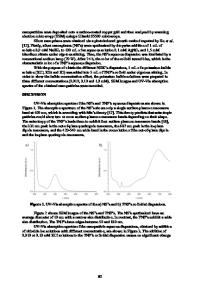The Effect of Silver Ion Occupancy on Hollandite Lattice Structure
- PDF / 1,490,747 Bytes
- 6 Pages / 432 x 648 pts Page_size
- 74 Downloads / 293 Views
MRS Advances © 2018 Materials Research Society DOI: 10.1557/adv.2018.238
The Effect of Silver Ion Occupancy on Hollandite Lattice Structure Alexander B. Brady1, Jianping Huang2, Jessica L. Durham2, Paul F. Smith2, Jianming Bai4, Esther S. Takeuchi1,2,4, Amy C. Marschilok1,2,4,*, and Kenneth J. Takeuchi1,2,* 1. Department of Materials Science and Chemical Engineering, Stony Brook University, Stony Brook, N.Y, 11794.
2. Department of Chemistry, Stony Brook University, Stony Brook, N.Y., 11794.
3. National Synchrotron Light Source II, Brookhaven National Laboratory, Upton, New York 11973.
4. Energy and Photon Sciences Directorate, Brookhaven National Laboratory, Upton, N.Y., 11973.
*corresponding authors: [email protected], [email protected]
ABSTRACT
The effect of tunnel cations on tunnel size in α-MnO2 structured (hollandite, cryptomelane) materials has long been of interest, as the tunnel size effects catalytic and transport properties. Previous research on the tunnel size has focused on potassium cryptomelane (KxMn8O16). This paper uses synthetic control of silver content in Ag xMn8O16 to investigate the effect that tunnel silver occupancy has on the lattice parameters. Materials with silver (x) content between 1.14 and 1.66 were synthesized, synchrotron diffraction and Rietveld Refinement was used to determine lattice parameters. The lattice parameters were found to contract as silver content increases (from 9.774 Å to 9.738 Å), in contrast to previous investigations of other tunnel cations.
INTRODUCTION Alpha-manganese oxide (α-MnO2), also called by the mineral names hollandite [1] or cryptomelane [2,3], is a tunnel structured manganese oxide material. The tunnel consists of 2 x 2 walls composed of edge and corner sharing manganese-oxide octahedra. Manganese octahedra within the same wall share two adjacent oxygens, while manganese octahedra in the corners only share one oxygen atom with their neighbors. Hollandites have been used as catalysts [4, 5], sorbents [6-9], and battery cathodes [1012]. The 2.5 angstrom tunnels can support insertion and deinsertion of many different ions. The manganese ions in the tunnel walls are stable at 3+ and 4+ oxidation states,
Downloaded from https://www.cambridge.org/core. Access paid by the UCSB Libraries, on 28 Feb 2018 at 08:17:37, subject to the Cambridge Core terms of use, available at https://www.cambridge.org/core/terms. https://doi.org/10.1557/adv.2018.238
allowing the material to be oxidized and reduced. Often the material is prepared with 1+ or 2+ ions occupying the tunnel. The tunnel ions in α-MnO2 materials are typically electrochemically inert (i.e. K+). However, in the case of silver hollandite, the silver cation (Ag+) is electrochemically active and can contribute Faradaic capacity upon its reduction. Previous publications have investigated the effect that the tunnel ions have on the α-MnO2 structure [13-15]. A review of α-MnO2 structures suggested that the presence of a metal cation within the tunnel (y in M yMnO2 or x in Mx
Data Loading...











